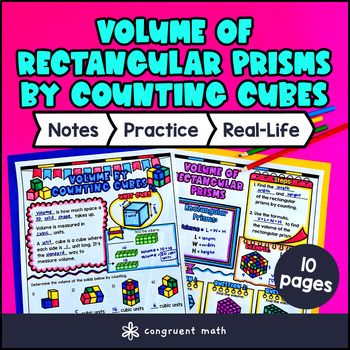Want more ideas and freebies?
Get my free resource library with digital & print activities—plus tips over email.
Join for Free Resources →
$4.25
Ever wondered how to teach volume of rectangular prisms by counting unit cubes in an engaging way to your 5th-grade students?
In this lesson plan, students will learn about volume and its real-life applications. Through artistic, interactive guided notes, check for understanding, practice with a doodle & color by number activity, and a maze worksheet, students will gain a comprehensive understanding of volume.
The lesson ends with a real-life example that explores how understanding volume can be applied to solve practical problems involving three-dimensional shapes.

$4.25
After this lesson, students will be able to:
Before this lesson, students should be familiar with:
As a hook, ask students why understanding volume and being able to calculate the volume of rectangular prisms is important in real life. Refer to the real-life application section of the guided notes for ideas on how to frame this question.
Use the first page of the guided notes to introduce unit cubes and the concept of volume by counting. Walk through the key points of identifying unit cubes and explaining the concept of volume.
Use the second page of the guided notes to introduce volume of rectangular prisms by using the formula V = L x W x H. Teach students how to count the number of unit cubes to find the volume of a given rectangular prism.
Based on student responses, reteach concepts related to unit cubes and measuring volume if needed. If students require additional support, consider pulling them out for reteaching while more advanced students can start working on the practice exercises.
Have students practice calculating the volume of rectangular prisms by counting cubes using the maze activity (pg. 3). Students solve math problems to escape the maze! Circulate around the classroom to answer any student questions.
Fast finishers can engage with the color by number activity (pg. 4) included in the resource for additional practice. Students solve math problems to unlock colors that eventually forms a colorful image. You may also assign it as homework for the remainder of the class.
Using the last page of the guided notes, bring the class back together, and introduce the concept of calculating the volume of a swimming pool to ensure the right amount of water is needed to fill it. Discuss how understanding volume helps pool owners determine the capacity required for chemicals, heating, and maintenance. Students read about some common real life applications for volume of rectangular prisms and then reflect on their learning. Refer to the FAQ for more ideas on how to teach it!
If you’re looking for digital practice for volume by counting unit cubes, try my Pixel Art activities in Google Sheets. Every answer is automatically checked, and correct answers unlock parts of a mystery picture. It’s incredibly fun, and a powerful tool for differentiation.
Here’s 1 activity to explore:
A fun, no-prep way to practice volume calculations of cylinders, cones, and spheres is Doodle & Color by Number — they’re a fresh take on color by number or color by code. It includes multiple levels of practice, perfect for a review day or sub plan.
If you’re looking for a way for your kinesthetic learners to engage with 3D shape nets, why not have them build emoji and Minecraft characters from 3D shape nets?
There’s different versions depending on your students’ needs:
You can also buy both as a bundle, and let students choose which to build.
Volume in mathematics is the amount of space occupied by a three-dimensional object. It is measured in cubic units.
To calculate the volume of a rectangular prism using unit cubes:
Unit cubes are small cubes with dimensions of 1 unit by 1 unit by 1 unit. They are essential in calculating volume as they help visualize and understand how many cubes fit into a shape to find its volume.
Understanding volume by counting unit cubes helps develop spatial reasoning skills, visualization of dimensions, and introduces the concept of volume as a fundamental measurement in geometry.
Students can apply the formula V = l × w × h to find the volume of a rectangular prism by multiplying the length, width, and height of the prism. This formula helps calculate the total space occupied inside the prism.
The calculation of volume of rectangular prisms is used in various real-life scenarios such as:
Students can visually represent volume of rectangular prisms by counting unit cubes through illustrations or physical manipulatives to show how the cubes fill the space inside the prism.
Get my free resource library with digital & print activities—plus tips over email.
Join for Free Resources →